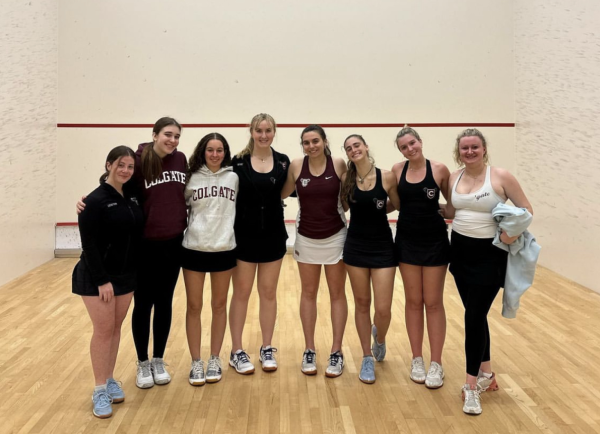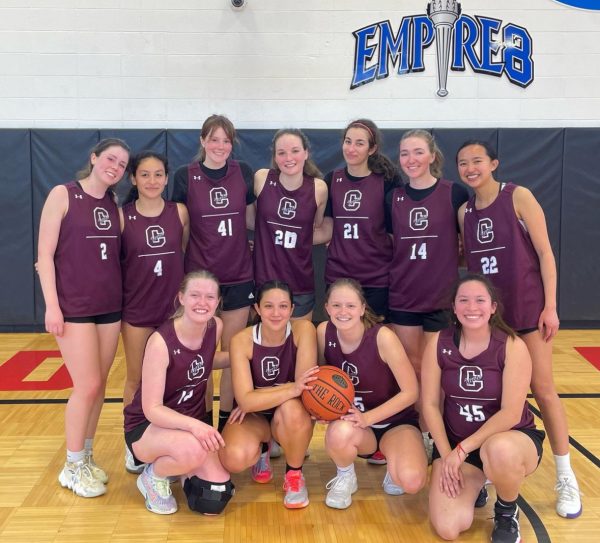Elizabeth De Palma: Showcasing Vulnerability
Elizabeth De Palma, a senior concentrating in art and art history with an emphasis in studio art, knew that she wanted to be part of the art world ever since she was a child. Her family has always placed a lot of emphasis on the importance of art, and De Palma says this is what got her interested in the field.
“Ever since I was little I’ve been super into art. My dad always brought me and my siblings to museums and stuff and he’s an artist on the side,” De Palma said. “My sister and older brother are also really artistic. I think just being around it since I was little kind of influenced that for me.”
De Palma wasn’t sure of exactly what she wanted to study upon arriving at Colgate, but after taking “Introduction to Studio Art” during her first semester, she knew that she wanted to continue taking art classes.
As an art major, De Palma has to be able to work with many mediums, but oil painting is her favorite. She finds inspiration for her pieces in the process of creating them.
“I’m the type of artist that, as I work on my piece, the conceptual aspects come into it, like, after I start actually working and getting into it.”
During the beginning of the COVID-19 pandemic when students were sent home, De Palma used quarantine as an opportunity to teach herself new techniques as well as make a difference in the world around her.
“I taught myself how to screen print while in quarantine, so I made a bunch of sweatshirts and sold them and donated part of the proceeds to Color Of Change … after George Floyd,” she said. “I just felt the need to help in some way and I like to use art to get into that.”
De Palma recently completed the thesis project required of all students concentrating in studio art, and she chose to focus on the vulnerability of women put on display.
“It’s called ‘Withholding,’ and the idea of the project is having these poses when you’re put on display, like these poses of kind of struggle withholding, and how – not necessarily this specific model of a woman – but just how women in general are really put on display and how the body moves,” she said, “and it was kind of an exploration of painting itself, as well.”
The project consists of five panels of acrylic hung in a row each displaying paintings of nude women in varying positions of covering themselves up. De Palma chose to paint on transparent acrylic, a material she had never worked with before.
“I knew I needed to push myself for this big project and I knew I wanted to do it with painting. And I feel like this really came into play because I wanted a material that would add to the concept of the project as well,” she said. “You can see into the next painting when it’s all hung in a row. So kind of that idea of movement, because you know when looking at these all in a row, this could be one movement throughout – almost like stop motion.”
The transparency of the acrylic panels made for a fitting material for De Palma’s capstone project.
“The reasoning for using the transparent canvas of acrylic or glass is that the material itself is vulnerable to crack, scratch, break, which kind of coincides with this image of women and not necessarily fragility, but vulnerability.”
Using nude images to comment on the vulnerability of women on display contrasts with the historical purpose of nude paintings of women, which De Palma says have existed as a way to appreciate or study beauty as a physical property through putting women on display, dehumanizing them in the process. She wanted to bring her perspective as a woman to reinterpret the classic style of painting.
In the presentation she prepared to give during the gallery show that marked the end of her thesis seminar, De Palma described the difficulties of working with nude images and the perception of women as fragile, with her project purposefully dealing with vulnerability rather than fragility.
“I aimed to critique the ways in which society holds women to certain standards and as I continued my research and my project grew, I wanted to distance myself from the notion of fragility being associated with women as this notion is most often only associated with that of white women. I did not want to perpetuate this idea by using a white model to convey female fragility.”
Once she graduates, De Palma is prepared to continue her work with an art gallery called Spacey Studios.
“I’ve been working for them for about a year now as an intern, but I’m going to be working with them after I graduate. But it’s not so art heavy in terms of, like, physical art-making, but it’s really cool because I got to help curate the art,” she said, “and I’ve always wanted to end up in the art world.”
De Palma has an art account on Instagram with the handle @lovelyedp where more of her work can be found.

Sophie Naylor is a junior from Middletown, CT studying geology, geography and Arabic. She has previously served as a staff writer for the Baker’s Dozen...












